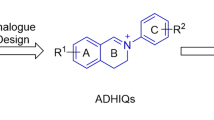Abstract
The antimicrobial and morphogenetic effects of fourteen newly synthesized 2-substituted derivatives of quinoline-4-carboxylic acid and quinoline-4-carboxamide were studied using G+ and G− bacteria, yeasts and filamentous fungi. The highest antimicrobial effects were found with substituted quinoline-4-carboxylic acid derivatives. Quinoline-4-carboxamides only weakly influenced the growth of the tested microorganisms. Some derivatives of quinoline-4-carboxylic acid elicited profound changes in the morphology of hyphal tips ofBotrytis cinerea, mainly their branching and the release of the cytoplasmic content. Quinoline derivatives, which elicited morphological changes, increased also the permeability of the plasmalemma of plant cells.
Similar content being viewed by others
References
Dobson R.A., O'Connor J.R., Poulin S.A., Kundsin R.B. Smith T.F., Came P.E.:In vitro antimicrobial activity of rosoxacin againstNeisseria gonorrhoeae, Chlamydia trachomatis andUreaplasma urealyticum.Antimicrob Agents Chemother.18, 738–740 (1980).
Holder I.A., Knoll C.A., Wesselman J.: Norfloxacin and silver-norfloxacon as topical antimicrobial agents: results ofin vitro susceptibility testing against bacteria andCandida sp. isolated from burn patients.J. Burn. Care Rehabil.7, 479–483 (1986).
Holm F.: Aminopropylacridans.Brit. Pat. 933 875;Chem. Abstr.60, 510a (1963).
Gudecová D., Jantová S., Melník M., Uher M.: New azidometalkojates and their biological activity.Folia Microbiol.41, 473–476 (1996).
Jantová S., Hudecová D., Stankovský Š., Špirková K., Ružeková L'.:Antibacterial effect of substituted 4-quinazolyl-hydrazines and their arylhydrazones determined by a modified microdilution method.Folia Microbiol.40, 611–614 (1995).
Kosakai N., Kumamoto Y., Sakai S., Hirose T., Okayama S., Shigeta S., Shiraiwa Y., Yoshida H., Miura Y., Ogata M.: Comparative studies on activities of antimicrobial agents against causative organisms isolated from urinary tract infections (1985). III. Secular changes in susceptibility.Japan J. Antibiot.40, 2026–2142 (1987).
Lackey N., Sternbach D.D.: Synthesis of substituted quinoline-4-carboxylic acids.Synthesis 993–997 (1993).
Lásiková A., Végh D.: Synthetic use of the Pfitzinger reaction in preparation of 2(3)-(di)substituted derivatives of quinoline-4-carboxylic acids.Chem. Papers51, 408–411 (1997).
Ligvoet E.E., Wicklerhoff-Minoggio T.:In-vitro activity of pefloxacin compared with six other quinolones.J. Antimicrob. Chemother.16, 485–490 (1985).
Majtánová L'., Majtán V.: Postantibiotic effects of imipenem and enoxacin againstS. typhimurium andS. enteritidis and the influence on their surface hydrophobicity.Folia Microbiol.43, 104–108 (1998).
Marble D.A., Bosso J.A.: Norfloxacin: a quinoline antibiotic.Drug Intell. Clin. Pharm.20, 261–266 (1986).
Nemec P., Betina V.: Permeability alterations in beet rootBeta vulgaris var.rubra caused by amphotericin B.J. Antibiot.21, 626–627 (1968).
Polónyi J., Ebringer L., Dobias J., Krajčovič J.: Giant mitochondria in chloroplast-deprivedEuglena gracilis late after N-succinimidylofloxacin treatment.Folia Microbiol.43, 661–666 (1998).
Sekar M., Prasad K.J.: Synthesis of some novel 2-oxo-pyrano(2,3-b)- and 2-oxo-pyrido(2,3-b)quinoline derivatives as potential antimalarial, diuretic, clastogenic and antimicrobial agents.J. Chem. Technol. Biolechnol.72, 50–54 (1998).
Wise R., Andrews J.M., Danks G.:In-vitro activity of enoxacin (CL-919), a new quinoline derivative, compared with that of other antimicrobial agents.J. Antimicrob. Chemother.13, 237–244 (1984).
Woodward R.B., Eastman R.H.: Dimerization of 6-methoxy-3,4-dihydronaphthalene.J. Am. Chem. Soc.66, 849 (1944).
Author information
Authors and Affiliations
Rights and permissions
About this article
Cite this article
Strigáčová, J., Hudecová, D., Varečka, L. et al. Some biological properties of new quinoline-4-carboxylic acid and quinoline-4-carboxamide derivatives. Folia Microbiol 45, 305–309 (2000). https://doi.org/10.1007/BF02817551
Received:
Issue Date:
DOI: https://doi.org/10.1007/BF02817551




